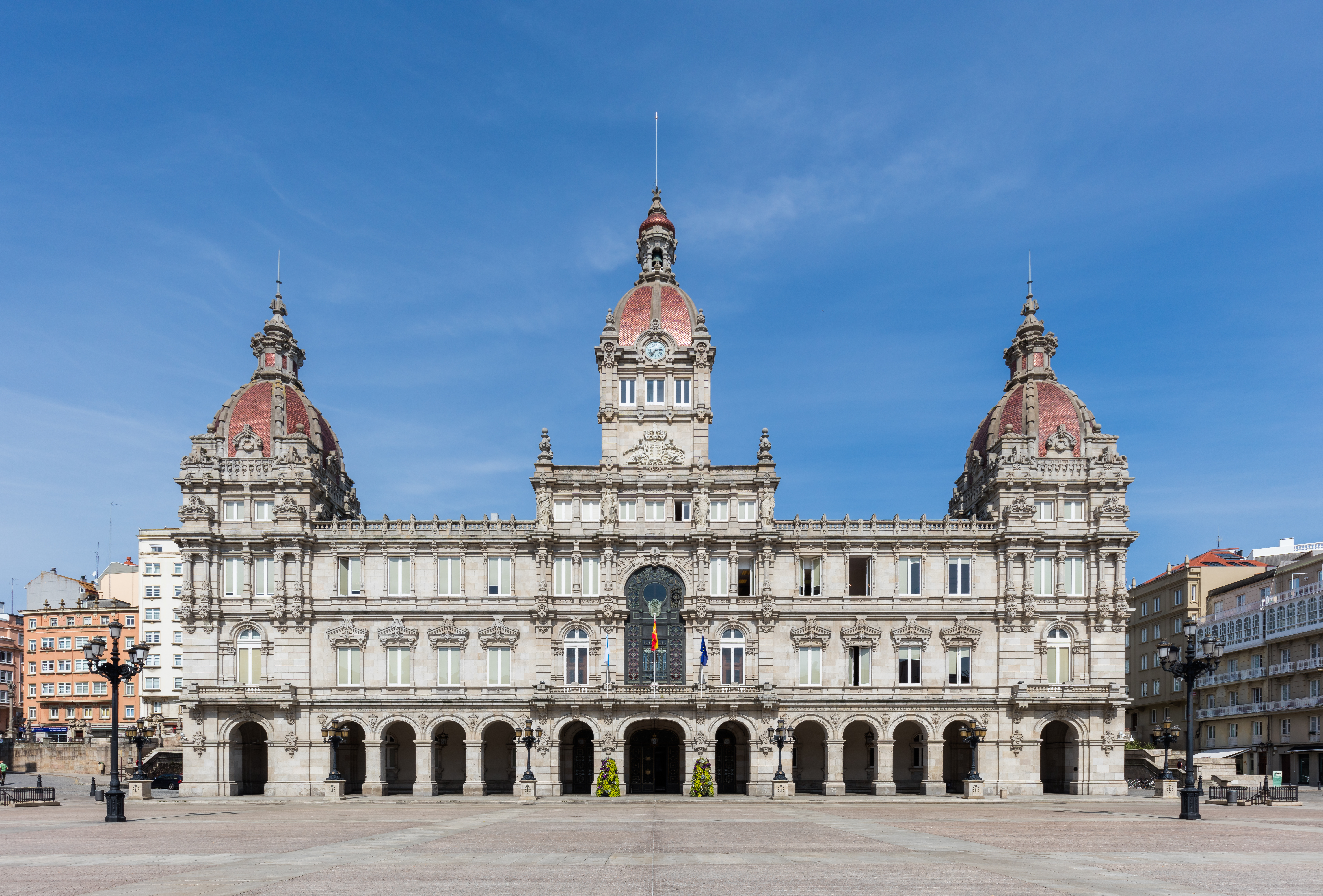
A Coruña
A Coruña (Galician: [ɐ koˈɾuɲɐ] ; Spanish: La Coruña [la koˈɾuɲa] ;[a] also informally called just Coruña; historical English: Corunna or The Groyne) is a city and municipality in Galicia, Spain. It is Galicia's second largest city, behind Vigo.[5] The city is the provincial capital of the province of A Coruña, having also served as political capital of the Kingdom of Galicia[6][7] from the 16th to the 19th centuries, and as a regional administrative centre between 1833 and 1982.
"Corunna" redirects here. For other uses, see A Coruña (disambiguation) and Corunna (disambiguation).
A Coruña
La Coruña (Spanish)
A Coruña, Elviña, Oza, San Cristovo das Viñas, Visma
Concello da Coruña
37.83 km2 (14.61 sq mi)
247,604
6,613/km2 (17,130/sq mi)
431,332
€25.231 billion (2020)
CET (GMT +1)
CEST (GMT +2)
+34 981 and +34 881
A Coruña is located on a promontory in the Golfo Ártabro, a large gulf on the Atlantic Ocean. It is the main industrial and financial centre of northern Galicia, and holds the headquarters of the Universidade da Coruña. A Coruña is the Spanish city featuring the tallest mean-height of buildings,[8] also featuring a population density of 21,972 inhabitants per square kilometre (56,910/sq mi) of built land area.[9]
Name[edit]
Origin[edit]
There is no clear evidence as to what the name derives from. It seems to be from Crunia, of unknown origin and meaning, documented for the first time at the time of Ferdinand II of León (reigned 1157–1188). As usual in Galician-Portuguese (as well as in Castilian Spanish), the cluster ni naturally evolved into the sound [ɲ], written n, nn or nh in old Galician orthography, nn in Spanish (later abbreviated to ñ, like the original Latin cluster "nn"), and nh in Portuguese and alternative Galician spelling. "A" is the Galician-Portuguese article equivalent to English the; compare Castilian Spanish la ("the").
One proposed etymology derives Crunia from Cluny, the town in France. During its height (c. 950 – c. 1130) the Cluniac religious movement became very prominent in Europe. There is another town named Coruña in Burgos Province.
A more likely possibility is that the name simply means "The Crown", which in Galician is A Coroa and in Spanish is La Corona. It seems less likely that it traces back to the Galician clunia. The name is reputedly from the Greek Κορώνα (Crown), referring to the crown of Geryon that was buried by Hercules under the lighthouse he built to his honour. The hero Hercules slew the giant tyrant Geryon after three days and three nights of continuous battle. Hercules then—in a Celtic gesture—buried the head of Geryon with his weapons and ordered that a city be built on the site. The lighthouse atop a skull and crossbones representing the buried head of Hercules' slain enemy appears in the coat-of-arms of the city of A Coruña, Loukeris (2019).[10][11]
A proxy evolution within the Portuguese language points out to the Latin word Colonya as its origin, where the L was transformed into R which occurs widely in Portuguese. A similar happening can be found today in Coronie, a Surinamese town which also made its course outside the Portuguese system.
A folk etymology incorrectly derives Coruña from the ancient columna, or Tower of Hercules.
Use[edit]
In English, use of the Spanish or Galician forms now predominates. However, the traditional English form Corunna /kəˈrʌnə/ is still often used in the UK, particularly in reference to the Battle of Corunna (1809) in the Peninsular War. Archaically, English-speakers knew the city as "The Groyne", probably from French La Corogne.[12] In Spain, the official form of the name is now the Galician one: "A Coruña", though many Spaniards continue to use "La Coruña". Despite this, "La Coruña" is in a constant decline, in favor of the official and historical form "A Coruña".[13]
Population[edit]
The province and city of A Coruña during the 20th century[edit]
After the War of Independence (1808–1814), the fortunes of Ferrol began to deteriorate. The largest port in northern Spain, site of the Reales Astilleros de Esteiro, one of the three Royal Royal Dockyards together with Cartagena and Cádiz, almost became a "dead" town during the reign of Ferdinand VII. By 1833 the City and Naval Station of Ferrol saw its civilian population reduced to 13,000.[22][23] During the administration of the marquess of Molina, Minister for Naval affairs in the mid-19th century new activities sprang up, but Ferrol never fully returned to its former glory. During those years, most of the Spanish colonies in Latin America succeeded in gaining independence from their former metropolis.
Politics[edit]
Domingos Rafael Merino Mexuto was the first mayor after the Spanish Constitution of 1978 for the PSG party (he is now in the BNG party), and he currently works at the Galician Ombudsman's (Valedor) office.
Francisco Vázquez Vázquez from the PSOE became mayor of the city in 1983; however, on becoming the Spanish ambassador to the Vatican, he was replaced by Javier Losada on 10 February 2006.
The mayor between 2015 and 2019 was Xulio Ferreiro, from the Marea Atlántica ("Atlantic Tide") party, who was largely elected in 2015 on an anti-corruption mandate. One of his main priorities was to reverse some of the very worst examples of town planning policy which has left a negative legacy in many areas of the city and its immediate suburbs.
The current mayor is Inés Rey of PSdeG-PSOE.